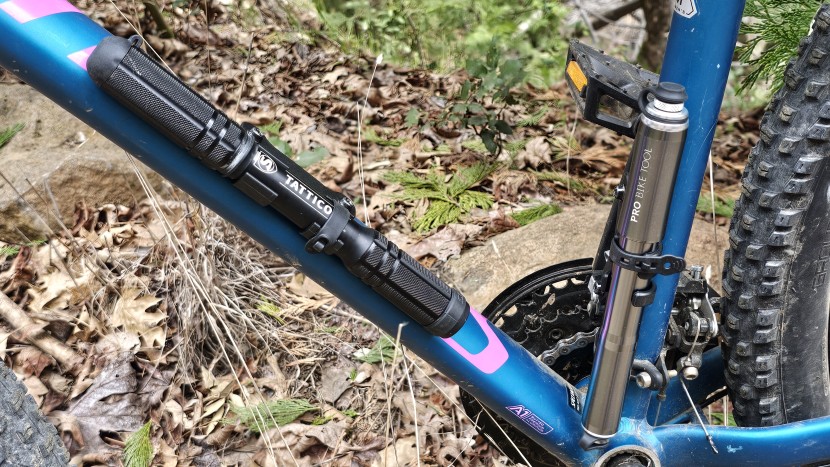We tested every pump in our review to the same exacting standard. We ran each pump through the following controlled and repeatable tests several times to rate pumping performance:
Pump Performance
Road Bike Tire Inflation
We used each pump to inflate a 25c Continental Grand Prix 4000, using a Presta Valve Butyl tube with all air removed before each test. We checked the pressure at 200 strokes using a Silca SuperPista Digital Pump.
Ability to Hit 100psi
We tested each pump on its ability to hit 100 psi in a 700x23c Vittoria Diamante Pro road bike tire. We recorded the approximate number of strokes required to achieve 90-100 psi, respectively (based on the manufacturer's advertised capacity of the pump).
Mountain Bike Tire Inflation
Using a Silca SuperPista Digital Pump, we measured the pressure of a 27.5" x 2.3" Maxxis DHF tire after 300 strokes.
The pump tests are designed to measure a product's ability to achieve a safe riding pressure in a road tire — 90psi is sufficient for most riders to avoid a pinch flat following inflation — and to efficiently provide the volume necessary to inflate a mountain bike tire.
The pump performance testing also gave us ample opportunity to test head design and valve seals. After thousands of strokes and elbow tendonitis from long hours inflating tires, we have completed the most exhaustive mini and frame pump review available.
The pumps were also tested in real-world riding conditions. They spent months in our jerseys, hydration packs, and on our frames. We intentionally rode around with a slow leak to ensure we had plenty of opportunity to test these pumps. We looked for signs of deterioration from the elements and assessed them for more nuanced issues, such as annoying rattles or noises while riding. You can rest assured that our award-winning products are deserving of their titles.
Ease of Use
This Metric was comprised of two sub-metrics – the Ease of Attachment and the Ease of Carry. Read more below about what we found when focused on these areas.
Ease of Attachment
A pump can be well-made and look pretty, but if it's not easy to attach, and perhaps more importantly if it does not create a good seal, then it may be more trouble than it's worth or do you little good when you find yourself trailside with a flat tire.
We attached and detached these pumps from countless numbers of Schrader and Presta valve stems. We paid attention to how easy they were to attach, any leaking that occurred with attaching and detaching, and if there was any leaking from the attachments while pumping, especially after the pump heated up with use.
Ease of Carry
If a pump's not easy to carry, then it may have a tendency to get left behind. Or worse yet, if it doesn't stay mounted because it's not secured well to the frame, then you may find yourself in need of your pump, and it's bailed on you back somewhere on the trail or road. We paid special attention here since one major complaint about a pump mount without a strap is that the pump inevitably falls off and is lost.
Durability
In this metric, we looked closely at the materials from which the pumps were constructed. We also gauged how well the parts were machined and put together. Metal pumps naturally scored higher overall than plastic pumps, since metal is generally more resistant to the elements and wear and tear. However, we also paid attention to the quality of the plastic used and scored accordingly when we noticed that one was more resistant to bumps and abrasion than another. We took each pump apart to look at the internals and how they were put together, identifying weak spots when we found them.
Ergonomics
For this metric, we wanted to assess which pumps are the most comfortable to use over time, i.e. how does your hand, your wrist, your elbow, your shoulders, etc. feel after 1000 strokes with the pump? The handle design is a major component of this test, and the handles that fold out to fit ergonomically in the grip were overall the most comfortable. Otherwise, you need to figure out if it's more comfortable to grip overhand, underhand, or some combination while delivering the necessary strokes. Each of these puts particular strain on the wrist and everything connected to it, which you may not notice at first or when you're fresh. But mid-trail, when your body is tired and a bit worn, it may become more apparent.
Weight
We're splitting hairs a bit in this category since we're talking about a matter of a couple/few ounces of weight between the contenders. Yet for some, namely amateur or professional racers and cross-country bike packers, this may be one of the most important considerations. We weighed each of these pumps with and without the mount (the mount adds 2-3 grams to each pump) to see how they compared.



